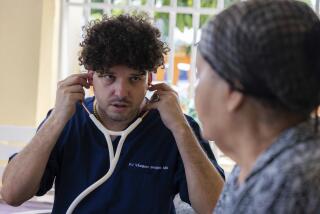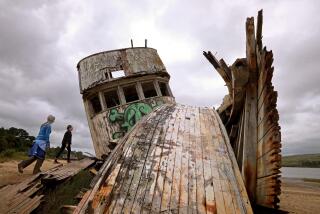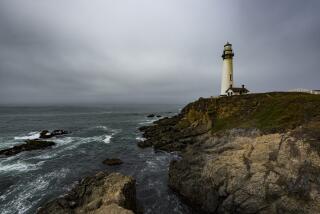Forays on Vieques
- Share via
Vieques, Puerto Rico — For 62 years, the U.S. Navy’s hulking presence kept this tropical idyll frozen in a Cold War time warp. During those decades when the military used the beaches for bombing practice, this serenely beautiful, 21-mile-long island off Puerto Rico’s east coast saw only a few thousand visitors a year, mostly harried urbanites seeking a respite from noisy, crowded San Juan. Paradoxically, the Navy preserved the beauty of Vieques for posterity.
Now the Navy is gone, driven away by protests after a fighter jet missed its target and a stray bomb killed a local civilian in 1999. But when the military packed up and left last May, a window of opportunity opened for real estate speculators, travel agents, hotel chains and cruise ship operators. All are eager to secure a piece of what may be the Caribbean’s last great tourist frontier: a low-key oasis of calm azure waters, lush green hills, wild horses that graze by single-lane roads and vast coral sea beds inhabited by iridescent fish.
My wife, Marla, and I came to Vieques near the end of a two-week Puerto Rican summer sojourn, and it turned out to be the high point of our first trip to America’s putative 51st state. After landing in San Juan on the Fourth of July, we rented a car and took a circular route around the main island of Puerto Rico, sampling its placid western beaches, prowling the charming colonial-era streets of Old San Juan and basking in the warmth of the people we met.
But even these attractions hadn’t prepared us for the isolated charms of Vieques. With a population slightly greater than 9,100 -- most of it concentrated around the sleepy southern village of Esperanza and the northern port town of la Segunda, the island’s de facto capital -- Vieques is still largely undeveloped and unspoiled. During a restorative three-day visit that allowed our L.A.-hardened heads and hearts to unwind, we snorkeled in see-through water, kayaked at the edge of a wild mangrove swamp and swam off deserted white-sand beaches.
Vieques and its smaller sister island of Culebra, a few miles north, are probably more deserving of the name “virgin islands” than the archipelago to the east and south bearing that name. Apart from a new plantation-style Wyndham resort, accommodations on Vieques consist of a few chic, boutique guesthouses and cozy, unpretentious inns. There’s a handful of good restaurants, but don’t expect to dine on four-star cuisine or disco till dawn. You won’t find a single traffic light, shopping mall or drive-through KFC on Vieques. Not yet, anyway.
Our odyssey began on the Puerto Rican mainland in the industrial eastern port town of Fajardo, where daily ferries shuttle passengers to and from Vieques and Culebra.
Forewarned that the ticket line would be long for the 9:30 Sunday morning ferry, we showed up before 7 a.m., just as a thunderstorm blew in from the east. For the next two hours we huddled with locals under the open-air ticket office roof until the ship loomed into view through the mist.
With ocean spray clinging to our hair and clothes, we arrived in Isabel Segunda as the storm lifted and quickly found a van to take us to our hotel, the Crow’s Nest. The hotel’s grounds crew was sweeping up storm debris when we arrived, but the manager was friendly and helpful in getting us settled. Like many Puerto Ricans, he segued easily from Spanish to English.
We had picked the Crow’s Nest over the more popular Inn on the Blue Horizon (whose website includes a thumb’s-up from travel author Paul Theroux), mostly because we had splurged in San Juan and didn’t plan to spend our time in Vieques lolling in a hotel room. The Crow’s Nest, set in a beautifully landscaped 5-acre hillside spread, was a fine alternative. Our room, with an outdoor deck and full kitchen facilities, was all we could have hoped for: secluded, clean, simply but nicely furnished and air-conditioned, all for less than the Blue Horizon’s rates.
Sated with surf and sand
Seated at the hotel’s picturesque open-air restaurant and bar, watching the remaining storm clouds break up over the Atlantic, Marla and I weighed our options. Vieques does have a few man-made attractions: the meticulously restored Ft. Conde de Mirasol Museum, which houses some interesting artifacts from Puerto Rico’s imperial past; and the Punta Mula lighthouse, with its superb views.
Well, maybe some other time. We had come here, unabashedly, for the surf and the trade winds-swept sensuality. So after picking up a bare-bones jeep clone at Island Car Rental, just paces from our hotel, we set off to explore the island’s southern coast, about 10 minutes away.
The island is only 4 miles wide, so getting around is easy. But unless you’re committed to walking everywhere, you’ll need a four-wheel-drive or a bike to reach isolated swimming spots.
As Marla nosed the vehicle along narrow, twisting roads, we passed clusters of wild horses, probably descendants of those brought here by the Spanish centuries ago. Initially, the Spaniards were unimpressed by Vieques and Culebra, which had been spotted by Christopher Columbus in 1493. Because they couldn’t find any gold here, the conquistadors dubbed them las islas inutiles, “the useless islands.”
Later, Vieques gave rise to lucrative sugarcane plantations before the Navy took over three-quarters of it in the mid-20th century. Much of its former landholdings are now under the U.S. Fish and Wildlife Service, which has created a national wildlife refuge of more than 18,000 acres interspersed with public access beaches. (A Navy spokesman said that “the areas where live ammunition was used” in the past “is a very limited area” that is still restricted to visitors.)
Estimates of the number of beaches on Vieques vary from 40 to 50. On our first afternoon we chose Sun Bay beach, one of the island’s most accessible and popular -- “popular” being a relative term in the summer off-season. Navio Beach, a bit farther east, was the setting for the 1963 film “Lord of the Flies” and is favored by surfers.
We picked a spot about halfway down the crescent-shaped beach and parked under a palm tree. The closest people were hundreds of yards away and barely visible. The water was tranquil and inviting.
On our way to the beach we stopped in Esperanza for a quick bite at Bananas, a funky, semi-outdoor fixture along a short strip of restaurants bordering the south coastal road. It’s a good place to grab a salad or a Jamaican-style jerk chicken sandwich and a beer. While we were there, one of the locals put his Jack Russell terrier on the bar so man and beast could watch the Mets game. Vieques is that kind of place.
That night we decided to try our hotel’s restaurant, the Island Steakhouse, reportedly one of Vieques’ best. Returning to the deck where we had breakfasted, we found the scene pleasantly transformed into a romantic but informal nighttime affair, with many attractive couples and families sitting down to dinner. What the menu lacked in choices it more than made up for in quality. I’d recommend the tamarind-glazed seared sirloin and any of the fresh fish dishes. And no one should leave Puerto Rico without sampling mofongo, the ubiquitous plantain dumplings.
Marla and I spent the next morning -- which was cloudless and dazzling -- back at Sun Bay, reading, swimming and scouting tidal pools and rock formations filled with mussels, crabs and other aquatics. We wanted to be near La Tienda Verde, or the Green Store, at the edge of Esperanza, where, at 1 p.m., we planned to meet with the owner of Blue Heron Kayaks for a kayaking and snorkeling trip that we’d purchased as part of our hotel package.
Our guide for the afternoon, Abe -- we never learned his last name -- was an amiable, well-traveled native of St. Croix in the U.S. Virgin Islands. Abe told us that his boyhood home and hangouts on St. Croix were now private playgrounds for the rich. He moved to Vieques a few years ago, lured by its six decades of Navy-enforced isolation from the mixed blessings of tourism.
“What do people do here to make a living?” Marla asked.
“Whatever they can,” he replied.
In our jeep, we followed Abe along a narrow dirt road through dense foliage, past Sun Bay, Media Luna and Navio beaches. Our destination, Mosquito Bay, is better known for the microscopic creatures that swim in it than for any buzzing ones around it. Its shallow saltwater is filled with microscopic dinoflagellates called pyrodinium (“whirling fire”), some of which are no wider than a human hair. At night they produce a phosphorescent glow that lights up fish, passing boats and human swimmers, creating a magical effect.
Nightfall was still many hours away. So after lashing our gear (including Abe’s ukulele) to our oceangoing kayaks, we paddled into the bay, looking for a way into the surrounding mangrove swamp. This proved tricky, as July’s low water levels had exposed impenetrable thickets of mangroves with gnarly roots resembling eagles’ talons.
Slathered in sunblock and wearing baseball caps, we spent several minutes scouting before deciding to paddle for the bay’s mouth, where Abe promised good snorkeling.
A few yards from the first line of breakers, we tied our kayaks together, dropped a small anchor and dived in. Immediately, we were in a world of bulbous brain coral and fish painted in vivid blues, yellows and oranges.
We spent an hour checking out the marine topography, then got back in our kayaks and paddled around a rocky point to an even more remote beach strewn with brilliant coral fragments, the kind usually carted away by kitsch merchants. Here they lay, swirling in the Caribbean’s cocktail of aqua, cobalt and indigo.
Abe said he would leave the beach to us for a while. “You can do whatever you want, you know what I’m saying?” he said.
We caught Abe’s drift, and for the next hour and a half we savored the warm, shallow water sans swimsuits. We rejoined Abe around 6 p.m. and found him near a stand of sea-grape trees, gathering driftwood for a small fire. After a tasty repast of pasta with chicken, mangoes and chocolate chip cookies, we set the driftwood ablaze and Abe unpacked his ukulele and began to strum and sing -- some Delta blues, some Bob Marley and one of those long nonsense ditties that only sound good around a summer campfire.
Light show by the bay
The sun was going down, and we knew we had only a couple of hours before the full moon rose and flooded Mosquito Bay with light, obscuring its phosphorescent shimmer. So we packed up our kayaks and headed back toward the middle of the bay.
Abe dipped his hand in the water and shook it. It was as if he were tossing a handful of pixie dust.
As Marla and I plunged in, Abe warned us to watch out for jellyfish. Instantly, our bodies became luminescent, like the aliens from “Close Encounters of the Third Kind.”
Abe flicked a flashlight at an oncoming boat packed with English-speaking tourists to make sure we wouldn’t collide. Through the darkness we could hear some of them splashing and singing their own version of the body electric.
“Let’s go chase some fish!” Abe yelled, thrusting his paddle into the bay and slapping it loudly against the side of his kayak.
The noise sent a school zigzagging through the depths, their bodies glowing like shooting stars. Our paddles were transformed into light sabers as we pushed ourselves to the far shore, where our trip had begun and now, alas, was ending.
It had been a dream of a day. Over a light bite at La Sirena, a cozy bistro on the south coastal road, we wondered how the next day -- or any other -- ever could match it.
Next morning we decided to explore the legendary Blue beach, formerly part of the Navy’s Camp Garcia.
It turned out to be the most picturesque place we saw on Vieques: a stunning quarter-moon of sand edging a turquoise lagoon and the small Isla Chiva a few hundred yards offshore.
We spent the day sprawled under an umbrella, reading books, paddling in the water and savoring the previous day’s pleasures. Late in the afternoon we moved farther down the beach and discovered coral beds even denser and more spectacular than those we’d explored with Abe.
One exquisite sea creature with a long needle nose eyed me, suspicious but unintimidated. It was a pure “Finding Nemo” moment. But my encounter with this wary local made me feel an intense pang for this wonderful island’s vulnerability. Its artificial isolation is coming to an end.
In the past, the U.S. military pumped $30 million a year into the local economy. It will be difficult to mitigate a flood of new beach houses and shopping centers in a place where more than 60% of the people live in poverty and badly need new jobs.
Two days later, while browsing the Museum of Art of Puerto Rico in the chic Santurce district of San Juan, we came upon Jorge Zeno’s 1956 painting “Vieques Bay.”
The huge canvas depicts an enormous black aircraft carrier towering over a small fishing boat in the foreground.
At Vieques, the aircraft carriers have moved on, but a new leviathan is on the horizon, approaching fast.
I wonder what Vieques will be like once its ship comes in.
*
(BEGIN TEXT OF INFOBOX)
Basking in the warmth of Vieques
GETTING THERE:
From LAX, American has nonstop and connecting flights (change of planes) to San Juan, Puerto Rico. Restricted round-trip fares start at $538.
To Vieques: Vieques Air Link, 358 Antonio G. Mellado St., Isabel Segunda; (888) 901-9247 or (787) 741-8331. Flies several times a day between San Juan and Vieques and operates on-demand flights between Vieques and Fajardo, Puerto Rico, a port town on the eastern side of Puerto Rico’s main island. One-way flights from $78; round-trip $151.
Isla Nena Air Service, Vieques Airport; (787) 741-1577, (866) 417-0521. Flies daily between San Juan and Vieques. One-way flight $70.
The Puerto Rico Port Authority, Playa Puerto Real, Fajardo; (787) 741-4761. Operates a passengers-only ferry service three times a day between Fajardo and Vieques. A one-way trip is about an hour. Round-trip tickets: $4 adults, $2 children.
A taxi from San Juan to Fajardo takes about a half an hour and costs $50-$75 plus tip.
GETTING AROUND:
I recommend renting a four-wheel-drive vehicle for getting around Vieques.
Island Car Rental, Route 201, Barrio Florida, next to the Crow’s Nest and about a 12-minute ride southwest of the ferry terminal at Isabel Segunda; (787) 741-1666. We rented a bare-bones four-wheel-drive jeep clone. Rentals from $40 a day.
WHERE TO STAY:
The Crow’s Nest, Kilometer 1.3, Route 201, Barrio Florida; (787) 741-0033, www.crowsnestvieques.com. A beautiful setting, friendly hosts, reasonable rates and a pleasant, casual atmosphere. Doubles $80-$99 in winter, $80-$85 in summer.
Inn on the Blue Horizon, Kilometer 4.3, State Road 996, Esperanza; (787) 741-3318, www.innonthebluehorizon.com. Doubles $225-$370 in winter, $105-$195 in summer. A stylish favorite with dramatic views and a top-notch restaurant.
WHERE TO EAT:
Island Steakhouse, Kilometer 1.3, Route 201, Barrio Florida; (877) 276-9763 or (787) 741-0011, www.crowsnestvieques.com. Great steaks, delicious fresh seafood. Come early Tuesday for happy hour (5-7 p.m.) and meet some locals. $17-$32.
Bananas Restaurant, Malecon in Barrio Esperanza; (787) 741-8700, www.bananasguesthouse.com. Superior salads, sandwiches and pizzas for less than $20.
La Sirena, on Malecon in Barrio Esperanza; (787) 741-4462. Sophisticated but inexpensive cuisine. Entrees $14.50-$20.
TO LEARN MORE:
Puerto Rico Tourism Co., 3575 W. Cahuenga Blvd., Suite 405, Los Angeles, CA 90068; (800) 874-1230 or (323) 874-5991.
-- Reed Johnson
More to Read
Sign up for The Wild
We’ll help you find the best places to hike, bike and run, as well as the perfect silent spots for meditation and yoga.
You may occasionally receive promotional content from the Los Angeles Times.







